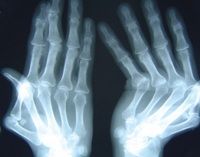Article
A 52-Year-Old Man With a Deforming Polyarthropathy
He had bilateral hand pain. History included rheumatic fever, aortic valve replacement, corticosteroid-induced osteonecrosis, and total left hip arthroplasty.

A 52-year-old white man presented with complaints of bilateral hand pain; he had a history of rheumatic fever, aortic valve replacement, corticosteroid-induced osteonecrosis, and total left hip arthroplasty.
The patient had been treated with oral corticosteroids and a biologic response modifier for several years for a diagnosis of rheumatoid arthritis (RA). Laboratory findings included negative antinuclear antibodies and rheumatoid factor (RF) test results and a normal erythrocyte sedimentation rate (ESR).

On examination, the patient was found to have ulnar deviation of both hands, along with mild subluxation at the metacarpophalangeal (MCP) joints, hyperextension of the proximal interphalangeal (PIP) joints, and flexion of the distal interphalangeal joints. There was no evidence of active synovitis in his hands or wrists.
X-ray films of both his hands were obtained and are seen here. A posteroanterior (PA) radiograph (top) of both hands firmly pressed against the plate shows hook erosions at the second and third MCP joints and mild periarticular osteopenia. Characteristic joint-space narrowing also is seen in the bilateral carpi. A PA radiograph (right) of both hands when lifted off the plate shows marked ulnar deviation that mimics RA and characteristic swan-necking of the first digit. In addition, an oblique x-ray view showed flexion deformities of the MCP joints.
What do the x-ray films show?
What is your diagnosis?
(Find the answer on the next page.)

The patient had Jaccoud arthropathy, a syndrome characterized by progressive, painless, and nonerosive deformity that affects the hands and, to a lesser extent, other joints. Patients may have pain that is predominantly mechanical in nature, unlike the stiffness and pain seen in RA.This pain is the result of mechanical disruption of the normal joint and instability.
Jaccoud arthropathy most often has been described as a sequela of chronic rheumatic fever1-3; the condition also is associated with systemic lupus erythematosus and scleroderma and is known to occur in cases of Parkinson disease and lung malignancy.4 Jaccoud arthropathy has been hypothesized to be a seronegative variant of RA because cases without an antecedent history of rheumatic fever have been identified. The condition also may be the result of chronic capsular fibrosis secondary to chronic disease.5
Bywaters1 outlined criteria for the diagnosis of Jaccoud arthritis, and others modified them.The following serves as a reasonable diagnostic outline:
•A history of repetitive attacks of acute rheumatic fever distinguished from those of RA by the transient nature of polyarthritis.
•Delayed recovery, associated with stiffness of the MCP joints, which later results in the appearance of joint deformity.
•Deformity appearing to be the result of periarticular fascia and tendon fibrosis rather than true synovitis.
•Deformity consisting of (a) flexion at the MCP joints (see oblique x-ray film above) and some associated periarticular soft tissue swelling, (b) ulnar deviation most marked in the fourth and fifth digits, and (c) ulnar deviation correctable by voluntary effort in the early stages.
•Associated hyperextension at the PIP joints.
•Tendon crepitus at the MCP joints and interphalangeal joints.
•Joint disease, usually inactive, with few or no symptoms and good functional capacity.
•A normal ESR and a negative RF.
•The earliest radiographic bone changes consisting of erosion of the metacarpal head on the palmar and radial part of the circumference in an anteroposterior projection, producing hook-like
erosion. (This deformity is not entirely specific for Jaccoud arthropathy; it also occurs in RA.)
A misdiagnosis of Jaccoud arthropathy as RA is made frequently on the basis of hand deformity,
as seen in our patient. However, a careful history and physical examination supplemented by radiographic and serological tests help differentiate one from the other.
Differentiating Jaccoud Arthropathy from Rheumatoid Arthritis
This case was submitted by Ramesh Pappu, MD, adjunct associate professor in the division of rheumatology at Drexel University College of Medicine in Philadelphia, and Humaira N.Adenwalla,MD, a second-year resident in the department of internal medicine at Mercy Catholic Medical Center, Drexel University College of Medicine.
References:
1. Bywaters EG. The relation between heart and joint disease including “rheumatoidheart disease” and chronic post rheumatic arthritis (type Jaccoud). Br Heart J. 1950;12:101-131.2. Rabkin SW, Fiedotin A. chronic post rheumatic arthropathy (type Jaccoud): report oftwo cases and a review of the American literature. South Med J. 1973;66:645-649.3. Thomas AE. Chronic arthritis after recurrent rheumatic fever. Ann Rheum Dis.1955;14:259-266.4. Johnson JJ, Leonard-Segal A, Nashel DJ. Jaccoud’s-type arthropathy: an associationwith malignancy. J Rheumatol. 1989;16:1278-1280.5. Ignaczak T, Espinoza LR, Kantor OS, Osterland CK. Jaccoud arthritis. Arch Intern Med.1975;135:577-579.




